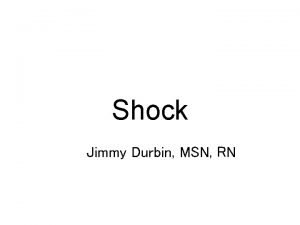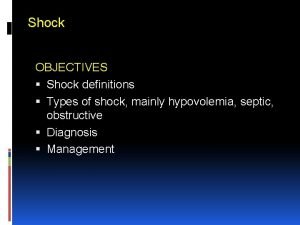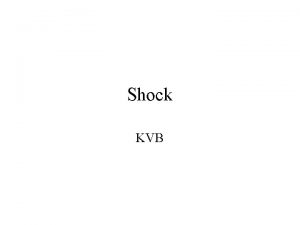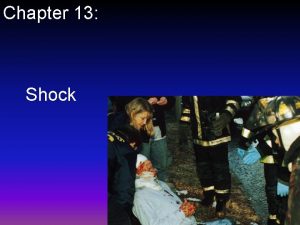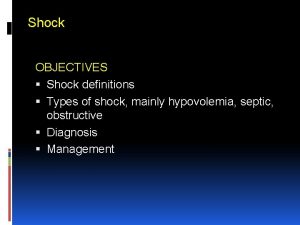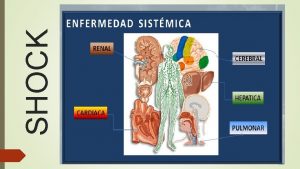MANAGEMENT OF THE CLIENT EXPERIENCING SHOCK Shock Definition



























- Slides: 27

MANAGEMENT OF THE CLIENT EXPERIENCING SHOCK

Shock Definition Syndrome characterized by decreased tissue perfusion and impaired cellular metabolism Imbalance in supply/demand for O 2 and nutrients Copyright © 2014 by Mosby, an imprint of Elsevier Inc.

Shock: Classification Ø Hypovolemic shock - due to decreased circulating blood volume in relation to the total vascular capacity and characterized by a reduction of diastolic filling pressures Ø Cardiogenic shock - due to cardiac pump failure related to loss of myocardial contractility/functional myocardium or structural/mechanical failure of the cardiac anatomy and characterized by elevations of diastolic filling pressures and volumes Ø Extra-cardiac Obstructive shock - due to obstruction to flow in the cardiovascular circuit and characterized by either impairment of diastolic filling or excessive afterload Ø Distributive shock - caused by loss of vasomotor control resulting in arteriolar/venular dilatation and characterized (after fluid resuscitation) by increased cardiac output and decreased SVR Copyright © 2014 by Mosby, an imprint of Elsevier Inc.

Shock facts Cardiogenic shock - a major component of the mortality associated with cardiovascular disease (the #1 cause of U. S. deaths) Hypovolemic shock - the major contributor to early mortality from trauma (the #1 cause of death in those < 45 years of age) Septic shock - the most common cause of death in American ICUs (the 13 th leading cause of death overall in US) Copyright © 2014 by Mosby, an imprint of Elsevier Inc.

Classification of Circulatory Shock HYPOVOLEMIC Fluid depletion (nonhemorrhagic) • External fluid loss Hemorrhagic - Dehydration • Trauma - Vomiting • Gastrointestinal - Diarrhea • Retroperitoneal - Polyuria • Interstitial fluid redistribution - Burns - Anaphylaxis Venodilatation • Sepsis • Anaphylaxis Copyright © 2014 by Mosby, an imprint of Elsevier Inc. • Toxins/drugs

Hypovolemic Shock - Low Blood Flow Clinical manifestations � Anxiety � Tachypnea � Tachycardia � Decrease in BP, MAP stroke volume, PAWP, urinary output � Cold clammy skin, (vasoconstriction) Pale If loss is >30%, blood volume is replaced Common Labs: Hct/Hgb, electrolytes, lactate, ABGs TX= Copyright © 2014 by Mosby, an imprint of Elsevier Inc.

Classification of Circulatory Shock. CARDIOGENIC Cardiomyopathic • Myocardial infarction • Left ventricle/Right ventricle • Blunt Cardiac Injury (trauma) • Myocarditis Arrhythmic • Bradycardia • Tachycardia Mechanical • Valvular failure (stenotic or regurgitant) • Hypertropic cardiomyopathy • Ventricular septal defect Copyright © 2014 by Mosby, an imprint of Elsevier Inc.

Classification of Circulatory Shock. OBSTRUCTIVE Impaired diastolic filling (decreased ventricular preload) • Direct venous obstruction (vena cava) - intrathoracic obstructive tumors • Increased intrathoracic pressure - Tension pneumothorax - Mechanical ventilation (with excessive pressure or volume depletion) - Asthma • Decreased cardiac compliance - Constrictive pericarditis - Cardiac tamponade Impaired systolic contraction (increased ventricular afterload) • Right ventricle - Pulmonary embolus (massive) - Acute pulmonary hypertension • Left ventricle - Saddle embolus - Aortic stenosis Copyright © 2014 by Mosby, an imprint of Elsevier Inc.

Classification of Circulatory Shock. DISTRIBUTIVE Septic (bacterial, fungal, viral, rickettsial) Toxic shock syndrome Anaphylactic, anaphylactoid Neurogenic (spinal shock) Endocrinologic • Adrenal crisis • Thyroid storm Copyright © 2014 by Mosby, an imprint of Elsevier Inc.

DISTRIBUTIVE- Septic Shock Copyright © 2014 by Mosby, an imprint of Elsevier Inc.

DISTRIBUTIVE- Septic Shock Clinical manifestations �Tachypnea/hyperventilation �Temperature dysregulation �↓ Urine output �Altered neurologic status �GI dysfunction �Respiratory failure Copyright © 2014 by Mosby, an imprint of Elsevier Inc.

DISTRIBUTIVE- Anaphylactic Shock Acute, life-threatening hypersensitivity (allergic) reaction � Massive vasodilation � Release of vasoactive mediators � ↑ Capillary permeability Swelling of the lips and tongue, angioedema � Anxiety, confusion, dizziness Wheezing, stridor Sense of impending doom Flushing, pruritus, urticaria � Chest pain Respiratory distress and � Incontinence circulatory failure Clinical manifestations Copyright © 2014 by Mosby, an imprint of Elsevier Inc.

DISTRIBUTIVE- Neurogenic Shock Hemodynamic phenomenon Can occur within 30 minutes of a spinal cord injury at the fifth thoracic (T 5) vertebra or above Can last up to 6 weeks Can occur in response to spinal anesthesia Results in massive vasodilation, leading to pooling of blood in vessels Copyright © 2014 by Mosby, an imprint of Elsevier Inc.

DISTRIBUTIVE- Neurogenic Shock Clinical manifestations � Hypotension � Bradycardia � Temperature dysregulation (resulting in heat loss) � Dry skin � Poikilothermia (taking on the temperature of the environment) Treatment aimed at symptoms Copyright © 2014 by Mosby, an imprint of Elsevier Inc.

Stages of Shock 1. Initial stage � MAP is decreased by less than 10 m g. 2. Nonprogressive stage � MAP decreases by 10 to 15 m g from baseline � Tissue hypoxia occurs in nonvital organs 3. Progressive stage � decrease in MAP of more than 20 m g � Vital organs are hypoxic 4. Refractory stage � Development of multiple organ dysfunction syndrome (MODS). Copyright © 2014 by Mosby, an imprint of Elsevier Inc.

Diagnosis and Evaluation Assessment, Lab and Diagnostic Tests Physical Assessment Hgb, WBC, platelets PT/PTT Electrolytes Arterial blood gases BUN, Cr Ca, Mg, Blood Sugar Serum lactate, Copyright © 2014 by Mosby, an imprint of Elsevier Inc.

Diagnosis and Evaluation. Monitoring 12 -lead ECG Chest x-ray Hemodynamic monitoring Arterial pressure catheter (monitors 2 systemic BP) 2 2 CVP monitoring (2 -6 mm Hg) Pulmonary artery catheter SVO 2 Copyright © 2014 by Mosby, an imprint of Elsevier Inc.

Collaborative Care Successful management includes: � Identification of patients at risk for shock � Integration of the patient’s history, physical examination, and clinical findings to establish a diagnosis General management strategies � Ensure patent airway � Maximize oxygen delivery � Increase supply Oxygen and ventilation 1. 2. 3. Optimize CO with fluid replacement or drugs Increase hemoglobin by transfusion Increase arterial oxygen with supplemental oxygen and mechanical ventilation Copyright © 2014 by Mosby, an imprint of Elsevier Inc.

Collaborative Care Fluid Resuscitation � Cornerstone of therapy for septic, hypovolemic, and anaphylactic shock = volume expansion � Isotonic crystalloids (e. g. , normal saline) for initial resuscitation of shock Volume expansion � If the patient does not respond to 2– 3 L of crystalloids, blood administration and central venous monitoring may be instituted Complications of fluid resuscitation Hypothermia Coagulopath Copyright © 2014 by Mosby, an imprint of Elsevier Inc.

Collaborative Care Primary goal of drug therapy = correction of decreased tissue perfusion � Vasopressor drugs (e. g. , norepinephrine) Achieve/maintain MAP >60 to 65 mm Hg Reserved for patients unresponsive to fluid resuscitation Continuously monitor end-organ perfusion � Vasodilator therapy (e. g. , nitroglycerin, nitroprusside) Achieve/maintain MAP >65 mm Hg Nutrition is vital to decreasing morbidity from shock � Initiate parenteral nutrition if enteral nutrition contraindicated or fails to meet at least 80% of caloric requirements Copyright © 2014 by Mosby, an imprint of Elsevier Inc. � Monitor protein, nitrogen balance, BUN, glucose,

Collaborative Care - Cardiogenic Shock Restore blood flow to the myocardium by restoring the balance between O 2 supply and demand Thrombolytic therapy Angioplasty with stenting Emergency revascularization Valve replacement Hemodynamic monitoring Drug therapy (e. g. , diuretics to reduce preload) Circulatory assist devices (e. g. , intraaortic balloon pump, ventricular assist device) Copyright © 2014 by Mosby, an imprint of Elsevier Inc.

Collaborative Care - Hypovolemic Shock Management focuses on stopping the loss of fluid and restoring the circulating volume Fluid replacement is calculated using a 3: 1 rule (3 m. L of isotonic crystalloid for every 1 m. L of estimated blood loss) Both crystalloids (such as normal saline solution) and colloids (like albumin) have a role in fluid resuscitation Copyright © 2014 by Mosby, an imprint of Elsevier Inc.

Collaborative Care - Septic Shock Fluid replacement to restore perfusion � Hemodynamic monitoring Vasopressor drug therapy IV corticosteroids for patients who require vasopressor therapy Antibiotics (after cultures are obtained) Broad-spectrum antibiotics given first Specific antibiotics given based on the organism identified Glucose levels <180 mg/d. L Copyright © 2014 by Mosby, an imprint of Elsevier Inc. Stress ulcer prophylaxis with histamine (H 2)-receptor

Collaborative Care - Neurogenic Shock In spinal cord injury: spinal stability � Treatment of the hypotension and bradycardia with vasopressors and atropine � Fluids used cautiously as hypotension generally is not related to fluid loss � Monitor for hypothermia Copyright © 2014 by Mosby, an imprint of Elsevier Inc.

Collaborative Care - Anaphylactic Shock Epinephrine, diphenhydramine Maintain a patent airway � Nebulized bronchodilators � Aerosolized epinephrine � Endotracheal intubation or cricothyroidotomy may be necessary Aggressive fluid replacement IV corticosteroids if significant hypotension persists after 1– 2 hours of aggressive therapy Copyright © 2014 by Mosby, an imprint of Elsevier Inc.

Collaborative Care - Obstructive Shock Early recognition and treatment is primary strategy Mechanical decompression Radiation or removal of mass Decompressive laparotomy Copyright © 2014 by Mosby, an imprint of Elsevier Inc.

Evaluation Normal or baseline, ECG, BP, CVP, and PAWP Normal temperature Warm, dry skin Urinary output >0. 5 m. L/kg/hr (>30 m. L/hr) Normal RR and Sa. O 2 ≥ 90% Verbalization of fears, anxiety Copyright © 2014 by Mosby, an imprint of Elsevier Inc.
 Cauda equina vs conus medullaris
Cauda equina vs conus medullaris Diferencia entre shock medular y shock neurogenico
Diferencia entre shock medular y shock neurogenico Spinal shock vs neurogenic shock
Spinal shock vs neurogenic shock Spinal shock vs neurogenic shock
Spinal shock vs neurogenic shock Spinal shock vs neurogenic shock
Spinal shock vs neurogenic shock Effciency
Effciency Linux leger
Linux leger Thin client vs thick client
Thin client vs thick client Anaphylactic shock
Anaphylactic shock 7 realities of experiencing god diagram
7 realities of experiencing god diagram What is habituation
What is habituation Nn teens
Nn teens What groups were experiencing poverty in the 1950’s?
What groups were experiencing poverty in the 1950’s? 7 realities for experiencing god
7 realities for experiencing god Experiencing english 1
Experiencing english 1 Hình ảnh bộ gõ cơ thể búng tay
Hình ảnh bộ gõ cơ thể búng tay Slidetodoc
Slidetodoc Bổ thể
Bổ thể Tỉ lệ cơ thể trẻ em
Tỉ lệ cơ thể trẻ em Voi kéo gỗ như thế nào
Voi kéo gỗ như thế nào Tư thế worm breton là gì
Tư thế worm breton là gì Bài hát chúa yêu trần thế alleluia
Bài hát chúa yêu trần thế alleluia Các môn thể thao bắt đầu bằng từ đua
Các môn thể thao bắt đầu bằng từ đua Thế nào là hệ số cao nhất
Thế nào là hệ số cao nhất Các châu lục và đại dương trên thế giới
Các châu lục và đại dương trên thế giới Công của trọng lực
Công của trọng lực Trời xanh đây là của chúng ta thể thơ
Trời xanh đây là của chúng ta thể thơ Cách giải mật thư tọa độ
Cách giải mật thư tọa độ








